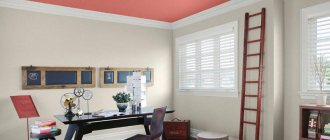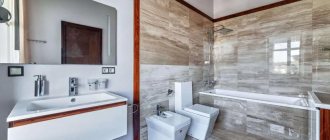An important part of comfort, coziness, and psychological sensations is the height of the ceilings in a private house. There are standards and rules that declare the specified parameter in relation to the purpose of the room. The height of the ceilings is of particular importance when it comes to designing a private house. For apartments, this parameter is strictly regulated - this range is from 2.5 to 2.7 meters.
Ceiling height in the living room
Correct planning further eliminates the issue of installing decorative elements inside the room. When solving a problem, as a rule, they prefer the standard option. The layout of the space in the boiler room requires special attention. It is possible to determine whether the choice was made correctly only after check-in. However, you can pay attention to important details and estimate the positive and negative aspects during design.
Pros and cons of different ceilings
The optimal ceiling height in a private house is an average value. If the task is to build comfortable housing without much sophistication at minimal expense, the most correct solution is to follow standard dimensions. At the same time, the standard dimensions of 2.6 meters easily avoid many disadvantages and make life in the house pleasant for its inhabitants.
A private house
High ceilings
They have their disadvantages:
- Costs during the construction phase of the building will be higher. This also entails increased costs for interior decoration.
- Complex organization of the heating system, the operation of which will require significant funds.
- Increased complexity of repair work. Repairers will be forced to use special structures. This entails an increase in the cost and time of repair work.
- Difficulties that occur in everyday life. A special approach is required when servicing and cleaning the premises. Even replacing a light bulb can cause difficulties.
Pros:
- They contribute to the formation of a specific atmosphere and a feeling of spaciousness.
- Lots of room for imagination when decorating. Such ceilings contribute to the creation of an individual floor design; it is possible to use several levels using various decorative solutions from plasterboard. They are perfect for the Baroque style, which involves the presence of a variety of stucco moldings, as well as for the classics.
Standard project
Experts recommend decorating a space with high ceilings following the “rule of three” - the walls are divided into three sections. The lower level is intended for auxiliary decoration, the middle level is occupied by shelves and paintings.
It is not recommended to place paintings below eye level, otherwise there will be a feeling of emptiness. The last section of the wall, the top, is left empty. This breakdown allows you to visually raise the ceiling level even more. For lighting it is recommended to use large chandeliers. Thanks to them, the room will become elegant and chic.
Low ceilings
Pros:
- They create a feeling of pressing overlap, which causes discomfort from staying in the room.
- It is impossible to use large chandeliers, especially in relation to a ceiling 2 meters high - a large chandelier will create an unfavorable environment.
- Restriction on decorative design - a multi-level ceiling will be irrational. Its creation is accompanied by difficulties, and its implementation in practice is only possible when turning to highly qualified specialists.
Ceiling height in a private building
The advantages of low ceilings lie in the disadvantages of high ones; it makes no sense to dwell on them in detail. When designing a room with low ceilings, experts recommend abandoning the following elements:
- lampshades, massive floor lamps;
- stucco on the ceiling, the use of volumetric decorative elements;
- large wardrobes, high tables and bulky sofas;
- Painted curtains fixed directly to the wall are suitable for ordinary ones - plastic ones fixed to the ceiling.
Designers believe that it is better to focus on the texture and color of the room. A good solution would be to use white as much as possible. This color helps to visually increase the space.
Hallway
The walls and ceiling can be decorated using shades of white. When decorating the interior of a room, it is preferable to use mirrored, glossy materials. Reflective surfaces also help to visually increase the cubic capacity of the room. The best solution is a glossy stretch ceiling.
How to adjust a room if the ceiling is high
Surprisingly, this is sometimes necessary. For example, in small rooms, high walls create the feeling of a well. And I want to avoid this. We recommend several working methods.
Multi-level
With the help of various protrusions, steps, convex parts and inserts, you can give the room not only an interesting and original look, but also reduce the space a little.
Tensile structure
Pexels
This method is not recommended for apartments where the vertical length of the walls is only 2.5 meters. The reason is simple: the structure is made with an indentation from the ceiling at a distance of 5-20 centimeters, since communications and sound insulation are located inside it. But for high ceilings and small rooms it is a good solution.
Plasterboard structures
This type also requires a setback from the main floor, which means it reduces the height. First, determine the degree of curvature of the surface of the concrete slabs. A ledge is made on top along the perimeter of the room, and LED lighting is placed under it. Pay special attention to it, since in the future it will be important what size the lamps are and the amount of wiring. Sufficient space must be provided for convenient installation and subsequent operation. Another aspect will be the shape itself. Drywall can be used to give the top floor a lot of interesting shapes. Therefore, design the number of levels in advance.
However, you need to be careful with this method so as not to make it even worse - the design can take away from 15 to 20 centimeters.
Pixabay
Or, as another interesting option, make a glossy or mirror insert in the middle, where there is no structural box. Thus, in contrast with the protrusion, this element will appear higher, and due to the reflection of light, the space will visually increase.
How to calculate the optimal ceiling height for design and renovation
As can be seen from the descriptions of different housing, the standard ceiling height may vary, it can be clarified and compared in the table below.
Table 1. Standard shelf height in different types of houses.
In addition to the standard one, there is such a thing as optimal ceiling height. It takes into account not only the SNiP requirements for microclimate and safety, but also the ergonomics of the premises and the combination of dimensions in all three dimensions. It should be noted that the optimal ceiling height should not be lower than the regulated one.
Table 2. Selection of optimal ceiling heights in various rooms.
| Terms, illustrations | Short description |
| Condition 1. Microclimate and air exchange | For living rooms and kitchens, the optimal ceiling height in the final finish should be no less than the height of the tallest family member plus 1 meter. This is due to the fact that the upper meter layer of air in the room contains a maximum of dust, bacteria and harmful gases formed during breathing and operation of heating devices. To ensure good health, you need to avoid inhaling air from this layer of air. With an average height of 170 cm, the finished ceilings are 2.7 meters high. |
| Condition 2. Heating and costs for it | You should not excessively increase the ceiling height - this will significantly increase the cost of heating. Thus, for a house with an area of 100 m2, an increase in the distance from floor to ceiling by 30 cm threatens to increase the cubic capacity of the building by 30 m3, which will require the installation of more powerful heating equipment and increase heating costs. |
| Condition 3. Number of storeys and layout | For a two- and three-story house, too high ceilings are also undesirable, and not only because of increased construction costs. The staircase to the upper floors with an increased ceiling height will take up a large area or will have a too steep slope, which is inconvenient and sometimes unsafe. If you want a spacious living room or hall in a two-story house, use a layout with a second light, as shown in the picture. In such a house, the ceiling height in the living room or hall occupies both floors. |
| Condition 4. Purpose of the premises | It makes no sense to make high ceilings in rooms with temporary occupancy: in a pantry, garage, small corridor. A height of 2.2-2.5 meters is quite sufficient for them. Also, you should not make high ceilings in the bathhouse and sauna - this will make it more difficult to heat it to the desired temperature. They have enough 2.2-2.3 m. |
| Condition 5. Room area | The basic rule: the more spacious the room, the more appropriate high ceilings are. So, for a living room or dining room with an area of 20 m2 or more, a ceiling height of 3.0-3.5 meters is suitable; for the kitchen, bedroom and nursery, 2.7-3.2 meters is enough; for a bathroom – 2.7-3.0 meters. You can achieve different heights in different rooms through suspended or tensioned structures and ceiling decoration. In addition, communications and ventilation systems can be hidden under them. |
Although the standard ceiling height is regulated by code, its value can vary greatly. When purchasing a new or secondary home, this parameter must be clarified in the technical passport for the apartment or house, or measured independently. When building a private property, it is better to be guided by personal needs and preferences, because the correctly chosen height of the premises will not only create the desired style and interior in the house, but also provide a comfortable environment there.
In what cases can you not comply with the rules?
The current standards regarding the height of premises can only be ignored during the construction of individual housing. If desired, in such a house you can make walls even more than 3.5 meters long. But a large area requires large expenses.
You may be interested in: House layout 8 by 10: features of construction and use of space
When trying to save money, a very small ceiling will ruin even the most beautiful mansion. Once construction is completed, it will be almost impossible to fix it.
It is best if you choose a standard height. Then, when using the house, you can avoid unwanted consequences. The rule of the golden mean applies here.
But there are also nuances when the standard size is not always the best. For example, if an intricate, unusual, unique structure is being designed. Or in the case of building a frame house, in the Finnish style, when the ceilings are lowered to 230 centimeters.
Standards and Practices
Despite the fact that the standard ceiling height of 2.5 meters is practically never found in new houses, this does not mean that after purchasing an apartment in a new building, a happy new resident will not receive rooms with low, oppressive ceilings. If the quality of construction leaves much to be desired, the ceiling surface will inevitably require additional leveling, which can significantly reduce the space. Therefore, the standard and practical conditions in a number of new buildings are different concepts.
Norms
Not a single regulatory document or standard establishes the only correct parameter. SNiP specifies only the minimum ceiling height. Below this parameter, construction is unacceptable. SNiP makes the following recommendations:
- In living rooms and kitchens, the lower figure is 2.5 m. For climatic regions 1A, 1B, 1G, 1D and 4A - 2.7 m.
- In corridors and halls, the ceiling height must be at least 2.1 m, which is determined by the safety requirements for the movement of people.
- Attics and rooms with inclined enclosing structures are allowed to be built with a height less than the standard one. The standard in this case determines the percentage of room space with low and standard ceilings. Ceilings with a lower height should occupy no more than half of the room.
- The height of the lowest part of the attic ceiling cannot be less than 1.3 meters if the slope is 30°. When the slope increases to 45°, the distance from floor to ceiling is not standardized by SNiP.
- For public buildings, SNiP sets a standard of 3 m.
- Residential premises located in public buildings are equipped in accordance with the recommendations developed for apartments.
Ergonomics issues
If the minimum distance from floor to ceiling is determined by SNiP, then ergonomics is involved in developing optimal parameters. The tasks of this science include calculating the room parameters that will allow a person to feel as comfortable as possible. It's no secret that a room with a low ceiling can feel pressured. A tall room with a small area will also be uncomfortable. Here a person feels as if in a well.
A comfortable room must meet the following ergonomic requirements:
- Sufficient amount of natural light.
- Sufficient amount of fresh air.
- Optimal humidity conditions.
Compliance with these requirements largely depends on the size of the room and the height of its ceilings. The optimal ceiling height was first substantiated by Dürer. Further research was carried out by the German architect Ernst Neufert, who developed modules with ideal parameters. These and other studies were subsequently taken as the basis for SNiP standards.
Briefly about the main thing
The standard ceiling height is determined by many reasons: the area of the house and premises, the region of construction, the purpose of the rooms, and an understanding of comfort. However, in different eras its meaning fluctuated in different directions under the influence of external circumstances.
In addition to the standard, balanced ones, there are high and low varieties of height, each with its own advantages and disadvantages. As a rule, the final solution is chosen for reasons of prestige or economy. You can bring the ceiling height closer to the standard one by visual means, using a play of color and pattern. Suspended and tensile structures and various decor (beams, stucco) will help make the room lower.
Ratings 0
In different types of houses
In apartments, the ceiling height can be different, as it depends on the building construction project. Today on the housing market you can find houses with both old and new layouts. For example, housing in “Stalinka” is characterized by a large area, the rooms are often decorated with beautiful platbands and stucco molding, and the height of the walls in them reaches from 3.2 to 3.5 m.
No less popular are the “Khrushchev” apartments, which are characterized by a small living area, good sound insulation and high-quality ceilings with a height of 2.5 to 3.2 m. With the change of era, they were replaced by apartments of a new type - “Brezhnevka”, their premises became more spacious, and the project even included the addition of hallways.
The majority of the housing stock consists of panel houses. The first buildings were built on 5 floors, the ceiling height did not exceed 2.5 meters.
Today you can buy an apartment not only in a five-story panel building, but also in nine-story buildings. It is difficult to renovate housing with such a layout, since you will have to not only visually raise the ceilings, but also dismantle the partitions.
As for the owners of apartments in new panel buildings, they are lucky, since the height of the ceilings of the rooms has become much larger - from 2.7 meters.
Houses of a new type deserve special attention; in their monolithic apartments, designers create a variety of types of layouts, thanks to which the housing becomes elite and meets all levels of comfortable living.
There are also economy-class apartments in new buildings, in contrast to the business class, which is characterized by a room height of 3 m; in them this figure is 2.7 m.
In an apartment building, some of the rooms may be located on the attic floor; as a rule, space is allocated there for bedrooms or kitchens. In order to organize the top floor as much as possible and make it residential, the height of the attic cannot be less than 2.1 m.
Geometric parameters of the room
Experts are unanimous in their opinion that ceiling dimensions range from 2.6 to 3 meters. In order to determine a more specific value, it is necessary to understand the layout of the building and indicate its purpose. Cyclic or seasonal operation of the building is possible.
Diagram of a two-story house with high ceilings
When it comes to a summer country house consisting of small rooms, you can stop at a ceiling height of 2.6 meters. Such buildings do not imply the presence of large living rooms and wide halls; high ceilings do not make sense.
However, when we are talking about a house as a permanent home, large bedrooms and spacious living rooms are well suited. This requires high ceilings, especially if you plan to place bunk beds.
Construction from timber
Why is height so important?
The standard ceiling height in an apartment (h = 2.5...3.2 meters) often does not allow its owner to realize his interesting design ideas. Having high ceilings in a house is always an advantage, because in such houses there is more light and air, and there is no feeling of enclosed space.
The design project of a room with high ceilings (h=3.2...3.7 meters or more) allows you to embody bright ideas and the most daring decisions.
To avoid the feeling of emptiness, in apartments with high ceilings you can not only hang a multi-level crystal chandelier, but also create an additional attic floor - a recreation area, to which a small staircase leads, and at the top there is an additional sleeping area and a library.
Arrangement of space in residential premises with high ceilings has some features:
For the interior of large rooms with high ceilings, it is recommended to choose massive large furniture
At the same time, it is important not to visually overload the room, so as not to erase the feeling of light and space
It should be noted that the design of a living space with a high ceiling is often done in the loft style (a modern style that can be described by the motto: “fewer partitions, more fresh air”). This style emphasizes the advantages of the room and organizes hidden places for storing things, effectively organizing the surrounding space. But for some owners of living spaces with high ceilings, the Art Nouveau style is to their liking.
Regardless of adherence to style, there is a vast field for imagination. Shaped arches, decorative elements of varying complexity, tension or suspended multi-tiered ceiling structures will look very beautiful and relevant in such rooms. Another advantage of such a room is that there will be no need to set the ceiling level to a centimeter, since they are invisible in the general space.
"Stalin" and older houses
Older buildings traditionally did not skimp on space, so the area and height of each individual room was quite large. The thing is that the historical period in which such houses were built was not characterized by the desire to provide all families with at least a small apartment.
The ceiling height standards in "Stalinka" buildings vary from 3.3 to 3.6 m, while the ceilings themselves are usually decorated with various decorative elements - for example, stucco molding or cornices. When installing suspended ceilings in such apartments, due to the large amount of finishing, it is necessary to significantly reduce their level.
Certain difficulties also arise due to the fact that wooden elements were often used to make floors in old houses, and the wiring was laid externally - repairing the ceiling in such conditions is not very easy, so you have to invest much more money in repairs.
However, an increased amount of free space has its advantages - in a tall room with a large area, you can arrange any style, and it will look quite appropriate. An excellent option, for example, would be a multi-level suspended ceiling, decorated with a variety of decorative elements.
Suspended ceilings of any configuration are generally very suitable for rooms with a high ceiling height - the availability of space allows you to painlessly reduce the volume of the room. Finishing the very basic ceiling in such rooms would be a bad decision - the existing ceilings usually have a lot of “congenital” defects, which are very difficult to hide.
Pros and cons of low ceilings
Low ceiling is a relative concept. For large rooms, a height of 2.8 may seem insufficient, and for a small bedroom, where a person spends time mainly lying down, a ceiling of 2.4 m will not look low. When choosing the height of ceilings in a country house, you need to focus on the size of the rooms so that their proportions are harmonious.
- cause a feeling of lack of freedom, pressure;
- limited in the choice of ceiling lamps;
- make design solutions such as tension or suspended structures impossible.
- give the interior an unpresentable look.
But they also have advantages, because by reducing the height of the walls in a private house, construction costs are saved and heating costs are reduced.
Taking into account all these pros and cons, the optimal ceiling height for each room in a private house is determined so that aesthetics and economics are in a reasonable balance.
Why is it important to observe the dimensions of brick walls during construction?
Load is the main parameter by which the thickness of a brick wall is calculated.
Since a building can have a different number of floors, weight and roof layout, functional purpose, as well as the area of the structure itself, the size of internal and external load-bearing structures is selected based on the expected weight of the superstructures.
If the calculations are incorrect, excessive weight will put pressure on the walls, which can lead to partial destruction of the brickwork or to a complete collapse of the entire structure. Also, if there is an overweight, the deformations may not be noticeable, but with the slightest seismic activity or physical impact on the walls, for example, a car accident, the building may collapse.
The second important parameter is the climate in which the building will be built. In this case, houses are divided into winter, summer, residential and non-residential. For structures that will be used by residents only in the summer or for storing things, the masonry is made less thick.
For winter residential or non-residential buildings, the thickness of the brickwork should be such that the walls do not freeze during frost. If the freezing line enters the area of the house, then a large amount of heat will be lost, the cost of heat energy will increase, the overall comfort of the room will decrease, and the interior design of the house (plaster, wallpaper) or household appliances may also suffer.
There are standards for optimal sizes for brick walls, which describe the required thickness. At the moment these are GOST R 55338-2012 and 24992-81.
They indicate that the thinnest brickwork can have a thickness of 12 cm. Most often, this size is used to build interior partitions or small fences.
The maximum optimal wall width is from 51 to 64 cm . This norm is intended for buildings with more than 4-5 floors, but a slight reduction in the size of the masonry is allowed for each additional floor.
Also, one of the reasons for choosing a thick or thin external wall may be the appearance and cost of materials. As the thickness of the masonry increases, the consumption of bricks and mortar increases, as well as its volume, which does not always have a good effect on the design of the house.
Design solutions and ergonomics
From an ergonomic point of view, the parameters of the room should be such that a person feels comfortable in an apartment, gym, or cinema.
There are several basic postulates of room comfort:
- optimal microclimate (comfortable temperature and humidity);
- necessary supply of fresh air;
- sufficient natural or artificial lighting.
The standard ceiling height in an apartment will allow you to create almost any floor structure, with the exception, perhaps, of heavy multi-tiered hanging devices. When making such design solutions, the height from floor to ceiling should be maximum.
In other cases, you can use any materials:
- ceiling tiles;
- tensile structures;
- simple suspended ceilings.
Ceiling tiles are suitable for finishing rooms with any wall height. It practically does not hide or reduce spatial scales. Easy to install and maintain. During repairs, any home craftsman can handle gluing. The only drawback is that it will not be able to level the floor slabs; moreover, when glued to an uneven surface, it can come off and negate all the work in the future.
Tension fabrics are the most acceptable option for finishing ceilings. They do not require special surface preparation. The width of the profiles on which the canvas is attached is not too large. But it is worth noting that multi-level structures should not be used in rooms with low ceilings. In such rooms, a single-level glossy or matte canvas with spotlights would be optimal.
Tension fabrics with a 3D effect and original lighting are possible, which can be selected taking into account the fact that the ceiling will visually look higher.
Suspended ceilings can bring to life the most daring design solutions. The installation of structures is carried out without preparing the base, especially since it is possible to hide light fittings and other communications under such a ceiling.
With high ceiling heights, you can create a multi-level, stylish and elegant form. In a room with low ceilings, it is better to opt for a single-level option with original built-in lamps or a chandelier that allows you to illuminate the ceiling surface from below.
"Khrushchev"
During the reign of Khrushchev, serious changes occurred in the construction industry. Thus, the main task set for the developers was to provide all families with their own housing. Of course, with such introductory housing, it was necessary to seriously reduce the housing, and the result of the design work was the “Khrushchev” - apartments with a very modest area and minimal ceiling height.
In classical apartments of the period under review, the ceiling was 2.5 m from the floor level. Individual apartments located on the first or last floor could have ceilings 0.1 m higher than the designated indicator. In the northern regions, the height from floor to ceiling in an apartment could reach 2.7 m.
For the manufacture of interfloor ceilings in Khrushchev-era buildings, reinforced concrete panels were used, which are easy to construct, quite reliable in operation and can be faced without problems. Accordingly, finishing ceilings usually came down to processing the joints in the slabs and applying whitewash.
Stretch ceilings, despite the reduction in ceiling height (even the simplest structures “eat up” about 5 cm), are used quite often in Khrushchev-era buildings. Lath or plasterboard structures are much less common - they require much more space to install. There is no need to talk about multi-level structures - they are completely inappropriate in such conditions.
By installing a suspended ceiling, you can try to compensate for the loss of free space by visually expanding the room. To achieve this effect, you need to very wisely select the colors and texture of the ceiling structure. It is better to use spotlights as lighting devices - installing large chandeliers in Khrushchev buildings is completely impractical.
What should be a comfortable ceiling height and what is this value in practice?
Ceiling height is an important parameter, the value of which determines the level of comfort in the room and the possibility of implementing certain design ideas. Different types of premises have their own standards. Such values are indicated in regulatory documentation, and ergonomics also deals with these issues.
Ergonomics of residential premises
The science of ergonomics develops parameters for the optimal ceiling height at which a person would feel as comfortable as possible.
To create a comfortable atmosphere during construction, the following ergonomic conditions must be observed:
- plenty of natural light;
- sufficient oxygen;
- maintaining optimal humidity conditions.
These requirements will differ depending on the size of the room.
The first optimal values were calculated by Dürer and Ernst Neufert (about 2.7 m). They are the basis for calculating standard ceiling heights in SNiP - building codes and rules used during construction.
Norms
It is worth noting that regulatory documents do not establish the only correct value, but only indicate the minimum ceiling height for residential premises of various types. Construction below it is not permissible.
- Living quarters and kitchens – 2.5-2.7 m.
- Corridors and halls – 2.1 m.
- Boiler rooms – 2.2 m.
- Baths, steam rooms, saunas – 3.2 m.
- Dry cleaners and laundries – 3.6 m.
- Offices and other administrative facilities – 3 m.
On practice
The modern indicator of the distance from ceiling to floor depends on many factors. The main one is the standard of living of the owners of the premises. In apartment and private buildings, as well as cottages that are built for further sale, developers can take into account the wishes of customers. As they say, every whim is for your money. Typically, the height of ceilings in a panel house fluctuates between 2.5-3.2 m. It is believed that a value of 2.5 m is the lower threshold at which there is no feeling of discomfort and a “pressing” effect.
The height of Stalin's ceilings
The height of apartments in Stalinist buildings is 3-4 m. They were built back in the 30-50s of the twentieth century during the reign of Stalin. These apartments are large and bright, have wide corridors, voluminous door and window openings, spacious bathrooms, kitchens, and rooms. We can safely say that such premises fully comply with ergonomic requirements.
Ceiling heights in Brezhnevka
High-rise Brezhnev buildings (from 9 to 16 floors) appeared in the USSR in the 70s. At first, the premises in them were called apartments with an improved layout. If you compare them with the rooms in Khrushchev, then it really looked like the truth. The distance from the floor to the ceiling surface in Brezhnev's houses is 2.5–2.7 m. The total area of the apartment is 20-80 sq. m. m.
Ceilings in new buildings
Today, different standards are applied when building houses. Elite class apartments can have a height of 3 m or more. The cost per square meter of such housing is significantly higher than average. In budget options, they stop at a value of 2.7 m, which is considered optimal both from the financial side and from the point of view of comfort. The average height of rooms in a nine-story building is 2.6–2.8 m.
Stretch ceiling
Tensile structures are recommended to be installed in high rooms from 2.7 m, as they tend to hide space. How much the ceiling height will be reduced depends on the type of mounted lamps and utilities. Typically this value is about 10 cm. The minimum distance between the main and suspended ceiling covering should not be less than 3 cm.
Advice! In low rooms (less than 2.4 m), stretch ceilings should be used with caution. The best option in this case is simple single-level structures
If the room allows, then the space for design imagination is not limited, and it is quite possible to settle on three- or four-level structures with complex configurations.
How to visually increase the height of the ceiling
If the room is low, you can add space to it visually:
- choose the right ceiling finish, such as a glossy finish;
- use materials of the same shade (white, milky, cream) when decorating walls and ceilings;
- highlight the boundaries between the wall and ceiling with a mirror strip;
- cover the walls with a pattern with a vertical orientation (the pattern should not be too frequent and not too bright);
- install cornice lighting (the cornice should be hung at a height of 5-10 cm from the ceiling).
The height of the room affects not only the cost of the housing itself and its maintenance, but also the well-being of those who live in it. This indicator determines the design options that can be used for decoration and is responsible for the comfortable atmosphere and coziness in your rooms.
Buildings made of panels and blocks
Initially, panel houses were built under Khrushchev. The standard configuration of such houses assumed that they would have five floors, and they would be built in the southern regions. The standard ceiling height in panel houses was about 2.5 meters, and the walls were built of brick. By and large, these buildings were very similar to typical “Khrushchev” buildings - there was little free space, and there was not enough natural light even on sunny days.
Renovation of houses made of panels and blocks occurred already in the 80s. The new buildings were distinguished by an increased number of floors, large area of premises and high ceilings - their minimum height was 2.65 m, and in some cases reached 2.75 m. Even with a superficial examination, we can safely say that such apartments were much more convenient.
This convenience was evident not only during the operation of the apartments, but also during renovations. Thus, finishing the ceiling was extremely simple - initially the surface of the floors was flat, so it could be arranged in any way. The high ceilings typical of such apartments made it possible to use suspended and suspended ceiling structures.
The most noticeable disadvantage of panel houses is the low level of sound and noise insulation. That is why during renovations it is always necessary to use high-quality materials to reduce the noise level entering the apartment from the outside.
Standard ceiling heights in different houses
Today, the concept of a standard ceiling height in a private house does not exist, because... it is not subject to regulation. Its choice is made at the design stage at the request of the future homeowner. To make it easier to make a choice, let's look at what level of ceilings were built in different types of high-rise buildings.
Stalinist buildings and old housing stock
One of the advantages for which Stalin-built houses are so valued is their high ceilings. Their level is 3.3-3.6 m; even modern luxury housing does not reach this parameter.
Khrushchev apartments
Khrushchev houses are low-budget housing; during their construction, the priority was not the quality, but the quantity of houses built. Therefore, the level of their ceilings complied with the minimum SNiP standards - 2.7 m for the northern regions and 2.5 m for the rest.
Panel and block houses
Although the last decades of the USSR are called an era of stagnation, noticeable progress can be seen in the size and layout of housing built in those years. Panel and block high-rise buildings built in the 80s are distinguished by a larger area and room heights of 2.65-2.75 m.
Modern apartments
The ceiling level of modern apartments depends on which segment of residential real estate they belong to. Economy options can have a height not reaching 2.7 m, business class housing - from 2.75 and above, luxury apartments - 3-3.2 m.
Private houses
So, what is the best ceiling height in a private house? The most optimal from the point of view of comfort and economic feasibility will be the “golden mean” - ceilings at a level of 2.6-3 m. For small rooms this parameter can be 2.6-2.7 m, for spacious ones - 3 m.
A reasonable solution would be to set the ceiling height in a private house as follows: build the floor on which the living room and dining room are located higher, and the floors with bedrooms lower.
It happens that you are not satisfied with the height of the walls in an already built house. If the task is to make the ceilings lower, then it is easily solved by installing suspended or tension structures.
And if the question is how to increase the ceiling height in a private house, then its solution is only possible in buildings with beamed floors. They can be lifted with a jack and complement the missing wall masonry. If the building has reinforced concrete floors, then this parameter can only be increased visually using design techniques.
Features of the boiler room space of a private house
The regulatory framework for a boiler room in a private house is regulated by the following documents:
- until 2003, the rules according to SNiP 04.08-87* were in force;
- from mid-2003 - rules according to SNiP 42-01-2002.
The documents contain rules for installing a boiler room in a private house.
Boiler options
You need to study the rules, but a special organization must design a boiler room for a private home. The owner has the opportunity to choose the installation of one or another boiler, and can estimate the amount of work to adjust the selected room to the established rules.
If any controversial issues arise, you must contact the gas supply organization. There are many nuances when designing a boiler room in a private house. Problems that arise can only be resolved in relation to the construction plan. The choice of installation location for a gas boiler in a boiler room is determined based on its power.
Utility room
Classification of houses by number of levels
First, let's look at what height houses exist:
- low-rise – buildings whose height does not exceed 12 meters, or 3 floors;
- mid-rise - the distance from the floor of the first floor to the roof reaches 15 meters, or 5 tiers;
- high – up to 10 floors and a height of up to 30 meters;
- multi-storey – up to 100 meters high (up to 25 levels). This category is divided into a number of subcategories I (up to 15 floors), II (up to 20), and III (up to 25) types.
- high-rise – minimum number of storeys from 25 and height from 100 meters.
The choice of materials for the “high-rise building” also depends on how many floors are planned to be built.
How to obtain permission for individual housing construction? What does a developer need to know?
Limiting authorities follow the development procedure and approve documents for individual housing construction according to RSN 70-88. Thanks to them, not only the accuracy of site development is determined, but also the layout of the home and auxiliary buildings. This project needs to be carefully considered, because what is not shown in the plan will be recognized as an unauthorized structure and must be demolished or re-approved.
Without permission, that is, before the plan is approved and documents are received, work should not begin, otherwise serious problems may arise. In order to find out exactly what documents will be required to start construction, you should read the “Code of Rules for Design and Construction SP 11-III-99”.
In order to obtain permission, you need to contact the BTI or the city architectural department to provide:
- application for planning permission;
- documents establishing the right to use the site;
- certificate of field determination of boundaries, placement of buildings, etc.;
- cadastral plan of the site;
- House project.
Once issued, the permit is valid for 10 years.
Fire safety standards for residential apartment buildings
Construction work on the creation of each individual building, and especially a residential building, must comply with safety requirements. The severity of control of these rules is determined by the number of floors of the building. They are the most “soft” in residential buildings up to 18 meters high (up to 9 levels), since this number of storeys corresponds to the length of a mechanical staircase installed on fire service vehicles.
The building design must provide for an emergency exit. If the number of floors is less than 9 floors, only 1 exit is allowed; if the building has from 9 to 18 floors, there must be at least two exits. If the house is a high-rise or type III multi-storey building, an emergency exit must be on each floor.
Another important requirement for buildings 10 levels or more high is the presence of a smoke-free staircase. Such platforms are very convenient for evacuation, but when used in everyday life they cause discomfort. Therefore, the most commonly used practice in the construction of multi-story buildings has become the design of a conventional staircase hall plus several external staircases.
Fire safety conditions are also applied to corridors. If the length of the room is no more than 40 meters, its width should be 1.4 m; if the length exceeds the specified distance, the width should be 1.6 m. In such long corridors of multi-storey buildings, it is recommended to install doors with a fire-resistant coating every 30 meters.
Important! It is also possible to install doors with reinforced glass on staircases and elevator landings.
The entire supporting structure of the building, walls, partitions located in the house, as well as staircases, must be made of materials that are least susceptible to combustion. The same rule applies to floors between basement levels.
Typical buildings of the USSR
Typical panel and brick 5-story houses began to be actively built during the times of Khrushchev, starting in 1957. The country needed cheap housing and as quickly as possible. That is why such projects were developed, some intended for the southern regions, others for the northern. The brick ones had a slightly better layout and room sizes.
The same serial project, built in different regions, could be slightly different. Different climatic conditions and the soils on which the construction was carried out made their own adjustments to the size of the five-story buildings. It is clear that each project differed in the height of the building.
The length of a 5-story building with 4 entrances for a typical 5-story building of project 1-528-3k is 72.4 meters. It depended on the layout of the apartments and slightly on the thickness of the panels. The wall thickness of the panels ranges from 300 mm to 400 mm.
Comparison of various design dimensions from the economic side
Calculation of savings and costs for a brick building should be made depending on its purpose, as well as the climatic zone.
For example, for a residential 1-3 storey building, which is located in a temperate climate zone, a masonry width of one and a half bricks (380 mm) may be sufficient, but at the same time you will have to spend money on insulating the house. Therefore, you should calculate what will be more effective: build a thicker wall or spend more insulation.
So for a residential apartment building a Kte of 2.1 is required , and for a 380 mm wall made of solid ceramic brick it is 0.63. Heat loss from the interior with such a gap will be high, so you will have to spend more money on heating.
When calculating for long-term use of the structure, the overexpenditure on thermal energy in the cold season can exceed in 2-3 years the amount that needs to be spent on insulation.
also choose the right brick . For example, solid and hollow ceramic bricks cost 10+ rubles/piece and 8+ rubles/piece, but when laying bricks with voids, more mortar will be used, which also affects the final cost. Hollow brick has a Ktp 2 times lower than that of monolithic brick, so a wall made of such material will require less insulation.
It is important to consider the height of a private or apartment building. If it is 1-3 floors, then you can limit the masonry thickness to 380 mm, but for better stability and durability you should make the masonry width 510 mm. If there are a large number of floors, the wall should be 640 mm thick to support the weight.
Classification of number of storeys of buildings
The following classification of residential buildings is distinguished, which differ in the number of floors:
- Low-rise (1 - 3). Most often these include individual residential buildings. The height of the building, as a rule, does not exceed 12 meters;
- Mid-rise (3-5). The height of the floors is 15 meters - this is a standard five-story building;
- High number of storeys (6-10). The building is 30 meters high;
- Multi-storey (10 - 25):
a) Category I - up to 50 meters.
Buildings with a maximum level of 17-18 floors; c) Category II - up to 75 meters. The height of a 15-storey building is approximately 55 meters;
c) Category III - up to 100 meters. Such buildings have a maximum of about 25 floors.
The number of storeys of a building is calculated solely by the number of above-ground floors. When calculating the number of storeys, not only the size from floor to ceiling is taken into account, but also the size of inter-floor ceilings.











